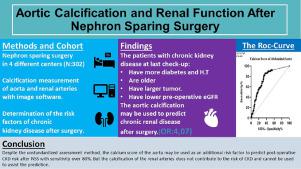Clinical Genitourinary Cancer ( IF 2.3 ) Pub Date : 2021-09-25 , DOI: 10.1016/j.clgc.2021.09.002 İlker Akarken 1 , Cenk Yücel Bilen 2 , Ender Özden 3 , Murat Gülşen 3 , Oktay Üçer 4 , Hayrettin Şahin 1

|
Introduction
This study aims to investigate whether the calcification of renal arteries and aorta may be risk factors for developing chronic kidney disease (CKD) after Nephron sparing surgery (NSS).
Materials and Methods
The patients that underwent either open or laparoscopic NSS from 2000 to 2019 in 4 different centers were retrospectively assessed. Of these patients, 328 had a non-contrast-enhanced computer tomography.
Calcium scores of the renal arteries and abdominal aorta were measured in the non-contrast-enhanced images with the calcium score plugin (version 2.0) of Horos™. Univariate and multivariate logistic regression analysis was performed to determine significant risk factors for developing CKD at the last check-up. Roc curve analysis was performed to determine the optimal cut-off values of age and abdominal aorta calcium scores.
Results
A total of 302 patients, of which 52 (16,6%) with CKD and 252 (83,4%) without CKD at the last check-up, were included in the analysis. The mean warm ischemia duration was significantly higher in patients with CKD (18,79±6,72 vs 16,38±5,57 minutes, p=0,016). The mean size of the tumor diameter and the number of the patients with ≥stage T1b were higher in the group with CKD (p=0,024 and 0,005, respectively). The median calcium scores of the aorta and renal arteries were higher in the group with CKD (p<0,001 and p<0,001, respectively). In multivariate analysis, age >60 years (OR:3,65, p=0,022), calcium score of the aorta (OR:4,07, p=0,029), tumor diameter (OR:1,03, p=0,026) and pre-operative CKD stage (OR:10,13, p<0,001) found the be significant factors for predicting last check-up CKD.
Conclusion
The calcium score of the aorta may be used as an additional risk factor to predict post-operative CKD risk after NSS with sensitivity over 80%.
中文翻译:

主动脉和肾动脉钙评分能否成为预测保留肾单位手术后肾功能的新因素?
介绍
本研究旨在调查肾动脉和主动脉的钙化是否可能是保留肾单位手术 (NSS) 后发生慢性肾脏病 (CKD) 的危险因素。
材料和方法
回顾性评估了 2000 年至 2019 年在 4 个不同中心接受开放式或腹腔镜 NSS 的患者。在这些患者中,328 人接受了非对比增强计算机断层扫描。
使用 Horos™ 的钙评分插件(2.0 版)在非对比增强图像中测量肾动脉和腹主动脉的钙评分。进行单变量和多变量逻辑回归分析以确定在最后一次检查时发生 CKD 的重要危险因素。进行Roc曲线分析以确定年龄和腹主动脉钙评分的最佳截止值。
结果
共有 302 名患者被纳入分析,其中 52 名(16.6%)患有 CKD,252 名(83.4%)在最后一次检查时没有 CKD。CKD 患者的平均热缺血持续时间显着增加(18,79±6,72 与 16,38±5,57 分钟,p=0,016)。CKD 组肿瘤直径的平均大小和≥T1b 期的患者数量较高(分别为 p=0,024 和 0,005)。CKD 组主动脉和肾动脉的中位钙评分较高(分别为 p<0,001 和 p<0,001)。在多变量分析中,年龄 >60 岁 (OR:3,65, p=0,022),主动脉钙化评分 (OR:4,07, p=0,029),肿瘤直径 (OR:1,03, p=0,026)和术前 CKD 分期 (OR:10,13, p<0,001) 发现是预测最后一次检查 CKD 的重要因素。
结论
主动脉钙化评分可用作预测 NSS 术后 CKD 风险的额外风险因素,敏感性超过 80%。











































 京公网安备 11010802027423号
京公网安备 11010802027423号